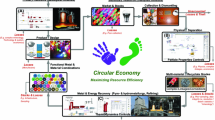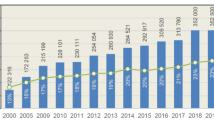Abstract
Purpose
This paper illustrates how a product-centric approach to recycling, building on the extensive expertise, knowhow and tools of the mineral-centric classical minerals and metallurgical processing, should be core to Design for Resource Efficiency (DfRE).
Methods
Process simulation (HSC Sim 1974-2014, Outotec's design tool) and environmental software (GaBi 2014) are applied to quantify resource efficiency (RE) in a rigorous manner. These digitalisation tools are linked and will be used to show how the environmental performance of copper primary production, the processing of residues and the recycling of e-waste, e.g. light emitting diode (LED) lamps as well as the production of nickel pig iron can be evaluated. The paper also shows how technologies can be compared relative to a precise thermodynamic and techno-economic baseline.
Results
The results include simulation-based environmental indicators, exergy, recycling and recovery rates, as well as the qualities and quantities of the recyclates, losses and emissions of materials during production recycling. The complete mass and energy balance simulation provides the mineralogical detail of all streams (both mineral and recyclate as well as offgas and dust) to define and improve environmental assessment, while at the same time revealing the aspects of LCA databases and their results that require improvement. Furthermore, this paper presents an approach for industry to implement life-cycle methods in practice. It shows that the DfRE is all about predicting stream grades and thus is equivalent to Design for Recyclate grade and quality (as this determines whether a recyclate or product stream has economic value and can be treated or processed further). DfRE also reveals especially the grade, composition, minerals etc. of the leakage streams, i.e. diffuse emissions, thus permitting a more precise evaluation of environmental impact.
Conclusions
The prediction of recyclate and stream compositions and grade makes the environmental analysis of systems more precise and will help to expand the detail that defines these flows on environmental databases. This is especially valuable for DfR, where the methodological rigour suggested in this paper is a very necessary addition and requirement for estimating the true environmental impact of product redesigns and the resource efficiency of processing technology and complete recycling systems. The methodology produces mass- and energy-consistent, economically viable best available technique (BAT) process blocks, the inclusion of which on environmental databases will be invaluable in benchmarking technology and systems in terms of estimating the achievable resource efficiency baseline.























Similar content being viewed by others
References
Ayres RU, Ayres LW (2002) Handbook of Industrial Ecology. Edward Elgar Northampton MA, USA, 680p
Biemer, J, Dixon W, Blackburn N (2013) Our environmental handprint the good we do. Institute of Electrical and Electronic Engineers. Presented at the 2013 I.E. Conference on Technologies for Sustainability 8 p
Brunner PH, Rechberger H (2004) Practical handbook of material flow analysis. Lewis Publishers, New York
Cartman R (2012) Nickel pig iron—a long term solution? 3rd Euronickel Conference. Hatch Associates Limited, Helsinki
EC (2012) Organisation Environmental Footprint (OEF) guide deliverable 3 and 4B to the administrative arrangement between DG Environment and Joint Research Centre No. N 070307/2009/552517, including Amendment No.1 from December 2010. Ref. Ares (2012)873788-17/07/2012
EC (2013) European Commission Decision C 8631 of 10 December 2013. Horizon 2020 Work Programme 2014–2015. Climate action, environment, resource efficiency and raw materials
FACT Sage 6.4: ©CRCT 2006-2013 (www.factsage.com)
Fagan JE, Reuter MA, Langford KJ (2010) Dynamic performance metrics of integrated urban water systems. Resour Conserv Recycl 54:719–736
Finkbeiner M, Schau MS, Lehmann A, Traverso M (2010) Towards life cycle sustainability assessment. Sustain 2:3309–3322
Finnveden G, Hauschild MZ, Ekvall T, Guinée J, Heijungs R, Hellweg S, Koehler A, Pennington D, Suh S (2009) Recent developments in life cycle assessment. J Environ Manag 91(1):1–21
GaBi 6, Software and System Databases for Life Cycle Engineering, Stuttgart-Echterdingen, www.pe-international.com (1992–2013)
Geisler G, Hellweg S, Hungerbühler K (2005) Uncertainty analysis in life cycle assessment (LCA): case study on plant protection products and implications for decision-making. Int J Life Cycle Assess 10(3):184–192
HSC and HSC Sim 7.1&8, Thermochemical and process simulation, Outotec Research Center, www.outotec.com (1974–2014)
Huda N, Naser J, Brooks G, Reuter MA, Matusewicz RW (2012) Computational fluid dynamic modeling of zinc slag fuming process in top-submerged lance smelting furnace. Metall Trans B 43(1):39–55
Huijbregts MAJ, Norris G, Bretz R, Ciroth A, Maurice B, von Bahr B, Weidema BP, de Beaufort ASH (2001) Framework for modelling data uncertainty in life cycle inventories. Int J Life Cycle Assess 6(3):127–132
Hunkeler D, Rebitzer G (2005) The future of life cycle assessment. Int J Life Cycle Assess 10(5):305–308
Klöpffer W (2003) Life-cycle based methods for sustainable product development. Int J Life Cycle Assess 8(3):157–159
Klöpffer W (2008) Life cycle sustainability assessment of products (with comments by Helias A. Udo de Haes, p. 95). Int J Life Cycle Assess 13(2):89–95
Krinke S, van Schaik A, Reuter MA, Stichling J (2009) Recycling and DfR of multi-material vehicles (as part of ‘Life cycle assessment and recycling of innovative multi-material applications’ by). In: Proceedings of the International Conference ‘Innovative Developments for Lightweight Vehicle Structures’, May, 26–27th 2009, Wolfsburg, Germany (Volkswagen Head Office), 196–208
Lloyd SM, Ries R (2007) Characterizing, propagating, and analyzing uncertainty in life-cycle assessment: a survey of quantitative approaches. J Ind Ecol 11(1):161–179
Pagan R (2009) Environmental life cycle costing: a code of practice. Int J Life Cycle Assess 16(5):389–391
Rebitzer G, Schäfer JH (2009) The remaining challenge—mainstreaming the use of LCA. Int J Life Cycle Assess 14:101–102
Reuter MA (1998) The simulation of industrial ecosystems. Miner Eng 11(10):891–917
Reuter MA (2011) Limits of design for recycling and “Sustainability”: a review. Waste Biomass Valorisation 2:183–208
Reuter MA, van Schaik A (2012) Opportunities and limits of recycling—a dynamic-model-based analysis. MRS Bull 37(4):339–347
Reuter MA, van Schaik A (2015) Product-centric simulation based design for recycling: Case of LED lamp recycling. J Sustain Metall 1(1):4–28
Swarr TE, Hunkeler D, Klöpffer W, Pesonen H-L, Ciroth A, Brent AC, Pagan R (2011) Environmental life cycle costing: a code of practice. Society of Environmental Toxicology and Chemistry (SETAC), Pensacola
UNEP Reuter MA et al (2013) Metal Recycling: Opportunities, Limits, Infrastructure”, United Nations Environmental Programme UNEP 316 p. http://www.unep.org/resourcepanel/Publications/MetalRecycling/tabid/106143/Default.aspx
Van Schaik A, Reuter MA (2010) Dynamic modelling of E-waste recycling system performance based on product design. Miner Eng 23:192–210
Van Schaik A, Reuter MA (2014) Material-Centric (Aluminium and Copper) and Product-Centric (Cars, WEEE, TV, Lamps, Batteries, Catalysts) Recycling and DfR Rules. In: Worrel E, Reuter MA (eds) Handbook of Recycling (doi:10.1016/B978-0-12-396459-5.00022-2), pp. 307–378
Von Krüger P, Silva CA, Vieira C, Aruajo FGS, Seshadri (2012) Relevant aspects relating to production of iron nickel alloys (pig iron containing nickel) in mini blast furnaces. In: Proceedings of The Twelfth International Ferroalloys Congress Sustainable Future, June 6–9, 2010, Helsinki, Finland, pp 671–680
Worrel E, Reuter MA (2014) Handbook of Recycling. Elsevier BV, Amsterdam, 595p
Xianyun C (2008) Methods on producing nickel bearing pig iron. Ferro-Alloys 4:1–7 (in Chinese)
Author information
Authors and Affiliations
Corresponding author
Additional information
Responsible editor: Martin Baitz
Rights and permissions
About this article
Cite this article
Reuter, M.A., van Schaik, A. & Gediga, J. Simulation-based design for resource efficiency of metal production and recycling systems: Cases - copper production and recycling, e-waste (LED lamps) and nickel pig iron. Int J Life Cycle Assess 20, 671–693 (2015). https://doi.org/10.1007/s11367-015-0860-4
Received:
Accepted:
Published:
Issue Date:
DOI: https://doi.org/10.1007/s11367-015-0860-4




